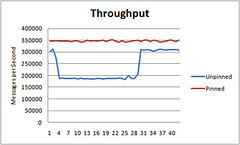Big Data Counting: How to count a billion distinct objects using only 1.5KB of Memory
 Thursday, April 5, 2012 at 9:15AM
Thursday, April 5, 2012 at 9:15AM 
This is a guest post by Matt Abrams (@abramsm), from Clearspring, discussing how they are able to accurately estimate the cardinality of sets with billions of distinct elements using surprisingly small data structures. Their servers receive well over 100 billion events per month.
At Clearspring we like to count things. Counting the number of distinct elements (the cardinality) of a set is challenge when the cardinality of the set is large.
To better understand the challenge of determining the cardinality of large sets let's imagine that you have a 16 character ID and you'd like to count the number of distinct IDs that you've seen in your logs. Here is an example:
4f67bfc603106cb2
These 16 characters represent 128 bits. 65K IDs would require 1 megabyte of space. We receive over 3 billion events per day, and each event has an ID. Those IDs require 384,000,000,000 bits or 45 gigabytes of storage. And that is just the space that the ID field requires! To get the cardinality of IDs in our daily events we could take a simplistic approach. The most straightforward idea is to use an in memory hash set that contains the unique list of IDs seen in the input files. Even if we assume that only 1 in 3 records are unique the hash set would still take 119 gigs of RAM, not including the overhead Java requires to store objects in memory. You would need a machine with several hundred gigs of memory to count distinct elements this way and that is only to count a single day's worth of unique IDs. The problem only gets more difficult if we want to count weeks or months of data. We certainly don't have a single machine with several hundred gigs of free memory sitting around so we needed a better solution...



















